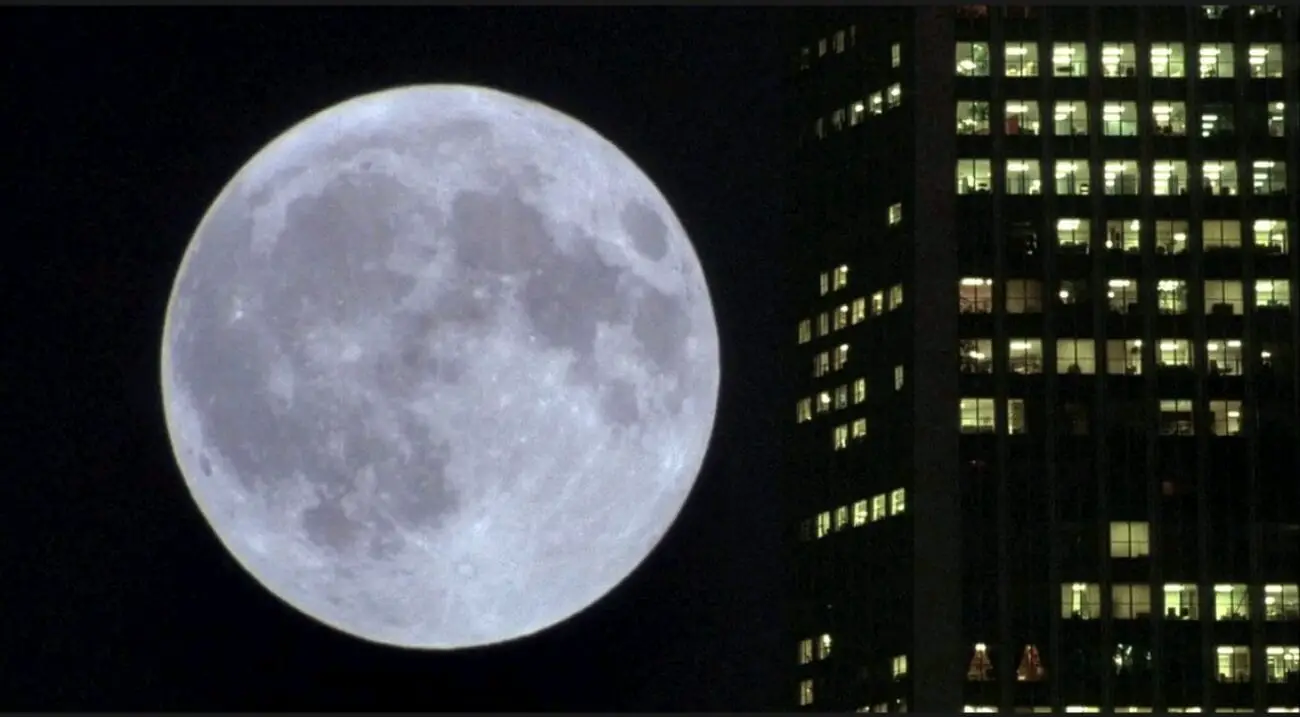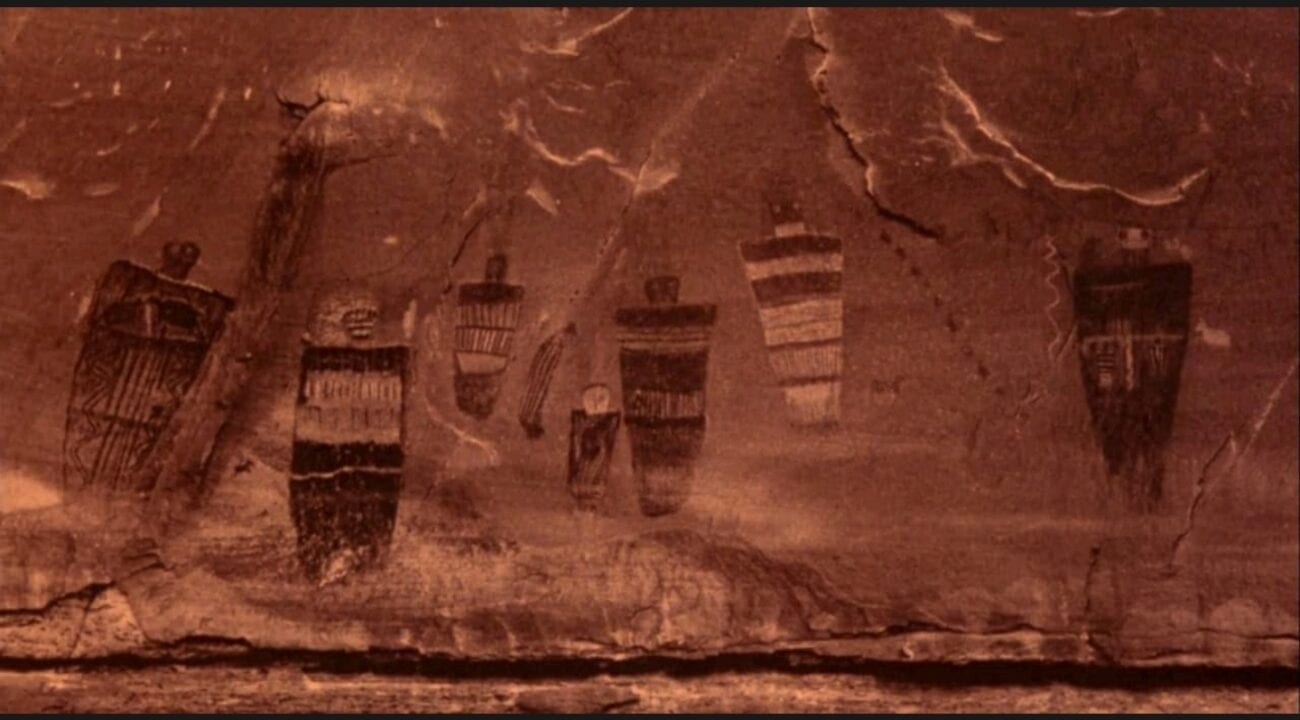Cinema, compared to other art forms such as painting or music, is a relatively new art form. From the early days of silent 15-second shorts in the 1900s to the colorful and extravagantly crafted narrative films of the present day, films and filmmaking are ever-changing. Documentaries, just like narrative films, have changed drastically from simplistic slice-of-life format films into more cinematic styles of storytelling by telling complex stories or diving into the life of specific people. However, while documentary filmmakers tend to use newer forms of storytelling through spoken dialog and narration, director Godfrey Reggio instead utilizes the pairing of visuals and music without narration in his wonderful debut film, Koyaanisqatsi (1983). In this seminal documentary film, Reggio explores the history of civilization from rustic and primitive beginnings to the more technological and economic methods of contemporary 1970s society through a variety of aerial shots and using time-lapse imagery to show the rapid movement speed of everyday life.
From the very beginning of the film, the audience is placed into a sense of foreboding with the slow chants of Philip Glass’s orchestra chanting the titular phrase “Koyaanisqatsi”. While this mantra is repeated numerous times, the start of a rocket launch is seen in slow motion with the thrusters going further away from the ground before the image fades out and goes into a more serene atmosphere. The drastic jump from showing the feats of modern society with an ominous atmosphere towards a more calming soundtrack while zooming out over various desert landscapes reflects a sense of worry towards modern technologies, while nature and wildlife are given a sense of yearning. And just as the scenes of aerial shots over the deserts are relaxing and beautiful in their serenity, the presence of industrial buildings and vehicles reintroduce a sense of uneasiness through their visual juxtaposition from the clean landscape surrounding these smog-churning monolithic figures. Cinematographer Ron Fricke, who would later go on to direct similar wordless-documentaries like Baraka (1992) or Samsara (2011), captures the beauty of the wilderness in these early scenes by giving them smooth camera motions and allowing the takes to remain steady and not feel visually chaotic.

As the film progresses, more scenes of everyday life and society are shown in urban metropolises and downtown settings. This shift into humanity becomes significant with the “Pruit Igoe” sequence from Philip Glass as scenes of demolition and destruction are shown in a montage format. As these buildings and structures topple, which are most likely destroyed for newer forms of architecture, the score evolves to become increasingly dramatic as the orchestra rises in volume while the constructions fall down. While a typical documentary would try to establish a reason for the destruction towards the audience, Reggio instead sidesteps any need for an explanation by allowing the numerous perspectives of destruction to signify the drastic actions modern society takes to remove buildings deemed as worthless in an economic sense, as they’re unceremoniously removed from the cities they exist in. The destruction scenes also underline civilizations’ tendency towards destruction and decay in the forms of these crumbling titans, while the introductory scenes of nature reinforce the stunning effect that natural environments have towards growth.
Further in the film, civilization is now in full focus as the audience is now fully immersed in various city landscapes. While Reggio and Fricke previously captured moments through more calm-moving camera shots and slow-paced scenes of movement, the film now increasingly speeds over time as a reflection of society’s tendency to rapidly evolve in terms of technologies and architecture. What was once flat landscapes and older buildings are now assembly belts and grid structures. As the rapid pace of civilization is seen in the more elaborate infrastructures pictured in the sequence of “The Grid”, the climactic music piece from Philip Glass starts slow but progresses at an increased pace as a synth machine repeats faster and faster. To match this frantic musical pace, images of social movements become rapid through time-lapse images showing movement patterns in near-line patterns. Factories become the organic lifeblood for civilization as assembly lines produce items of consumption, just as the organs in a human work in production patterns to sustain the host’s body every day. Through showing the same movement pattern multiple times in various environments throughout this segment, Reggio highlights the mundanity of modern living as people are forced into a ritualistic and unstimulating daily routine in order to thrive and live. In addition, Glass’s score becomes another victim of cycling patterns as the same music rhythm repeats over and over again, bombarding the audience with the same sensory overload that people encounter in their lives when going through their day. And as the cycle increases in speed, the score becomes louder until the moment becomes a crescendo of both speed and volume.

After this climactic and energetic sequence, the film becomes more sullen and slow with the remaining final act of the film. While “The Grid” could be seen as triumphant in its boisterous volume and speed, the “Prophecies” segment of the film is instead dour in nature. Slowing back down to a more contemplative pace and tone, both the decay and poverty of the urban metropolis is revealed in excruciating detailed close-up shots and slow-motion photography. While the crowds of “The Grid” were hidden in their fast-moving lines and flashing lights, the people highlighted in “Prophecies” instead take up most of the camera frame. Fricke’s cinematography shines in this melancholic moment as people are often shown in sad or stressed facial expressions while looking directly towards the camera, almost as if beckoning the audience to see how miserable life in the city can become for most people. The chants, which were highlighted at the beginning of the film, return with full force and bellow out mantras of anguish the people within the frame seem to be expressing. While “The Grid” shows the effect that technology can create for people to live comfortable lifestyles, “Prophecies” on the other hand, exposes the pain that less-affluent people experience as pieces of the economic machine. The audience doesn’t see businessmen in formal attire or citizens experiencing luxury as they did before, but they instead see the impoverished and homeless that society keeps out of the public spotlight. As a result, this final act asks the audience to consider the effectiveness of modernization, as these struggling individuals don’t benefit from the technological and economic evolution of the modern world.
As the film concludes, the audience is returned to the rocket launch that was previously cut off at the beginning of the film. As the launch advances, the rocket is shown in a close-up shot soaring towards the sky before suddenly exploding, with a piece falling in slow motion towards the surface of Earth. This Icarus-like image is a powerful final image of humanity’s technological progress as it reveals that even the most advanced society can suddenly erupt at the height of their ability and prowess. This image also reinforces the futility of seeking to create increasingly sophisticated technologies, as it ends with an anticlimactic explosion that doesn’t match the expectation of greatness teased at the beginning of the film. And with the rocket’s explosion, the image fades to a cave painting that was also introduced at the beginning of the film before cutting fading to black with a title card revealing the drastic definition of the film’s title, hammering the importance of moderation in humanity’s technological desires. This cave painting as a final image is a significant highlight that humanity has the ability to evolve and change drastically over millennia, but if society cannot temper its abilities and desire for progress, then it is destined to fail in a violent and sudden fashion.




